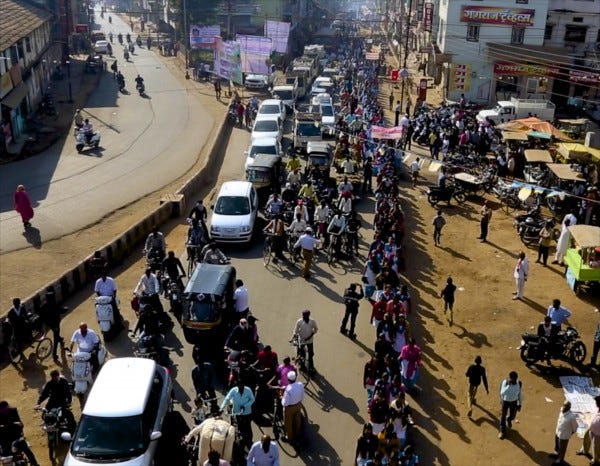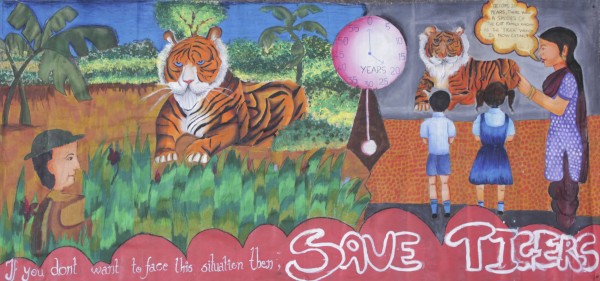
We pulled out of the honking pandemonium of morning traffic into the cement schoolyard of Chhotubhai Patel High School. It was only slightly quieter than the street. Hundreds of kids milled about or huddled in small groups, practicing cheers that blended into a rhythmic, unintelligible wall of sound.
Those who weren’t dressed in school uniforms sported tiger T-shirts that proclaimed “LEAVE ME ALONE” in bold type. Photographer Steve Winterand I jumped out of the car: We’d come to film this rally. Kids with painted tiger faces roared at us as we weaved through the crowd.
Shortly, 1,200 students streamed into the streets of the small central Indian city of Chandrapur, halting traffic. They screamed with deafening exuberance, so loud it echoed off the buildings. Save the tiger! Save the forest! Everyone — pedestrians, motorists, store owners — stopped to watch.
Many of the marchers carried signs and banners in English and Hindi that identified their affiliation, Kids for Tigers. These high schoolers are part of a groundswell youth movement that is now more than a million strong across the country. I had chills watching them. Despite the constant, heartbreaking news I hear almost daily about the tiger’s continuing demise, these kids inspired hope.

The program is the brainchild of Bittu Sahgal, a man who fell in love with tigers on a safari to Kanha National Park in 1973. It was the same year Indira Gandhi launched Project Tiger to rescue the cat from extinction. Repeated expeditions into India’s national parks turned him into a part-time activist. He used skills he’d gained working in advertising, writing newspaper articles, and campaigning, sometimes successfully, against assaults on the land in key tiger habitats — particularly around India’s nine newly-established tiger reserves. Mines, dams, roads, chemical complexes, and other development were creeping, like mange, into tiger habitat, he said.
A campfire conversation transformed him into one of India’s most influential tiger defenders. In 1980, Sahgal asked Fateh Singh Rathore, the head of Ranthambore Tiger Reserve, how he could help tigers. “Start a wildlife magazine,” Rathore said, “so that city people learn to appreciate wildlife and do less damage!” Sanctuary Asia was born 10 months later, India’s first environmental news magazine, which Sahgal still edits.
Then came Sanctuary Cub, a bi-monthly kid’s magazine, a 16-episode “Project Tiger” TV series, (which was viewed by some 30 million people), and a children’s TV series on conservation. Eventually, Sahgal was posted to high-profile government committees, where he and others who fought to protect natural resources were ignored or summarily dispatched by those pushing for big development projects. “Our advice was found unpalatable,” he said.
To fight his growing cynicism, he turned to India’s youth: In 2000, he launched Kids for Tigers. “They have the greatest legitimacy to ask for a better tomorrow,” he said. “Essentially, we wanted to give the children a voice. We wanted to explain…that you can make a difference.”

The program has created a new generation of tiger advocates through nature walks, educational films, camps, and a conservation agenda that’s been adopted by more than 500 schools in 20 cities. Kids for Tigers started in urban centers — New Delhi, Mumbai, Calcutta, Bangalore — and then branched out into smaller towns and cities like Chandrapur that border tiger reserves. “We now have a veritable army of young kids,” said Sahgal.
It’s an easy sell. This huge orange-and-black cat is deeply woven into India’s history, religion, and folklore. The Hindu goddess Durga vanquished a monster-demon while astride her ferocious mount, a tiger. Some Indians refer to the tiger as a striped water-god who creates rain and can end drought. The cat is thought to keep nightmares away and to lead lost children to safety. Pulikali dancers in Kerala, along India’s southern coast, paint themselves as tigers for an elaborate harvest festival that celebrates the cat’s power and strength. And the tiger is, after all, India’s national animal.
~~~~~~~~~~~
We went to St. Gregorios School in Mumbai to film a Kids for Tigers school assembly. There I met 12-year-old Kush Somaiya, who was in full tiger face paint. He told me that a few years ago, before the program took him and his classmates into nearby Sanjay Gandhi National Park, he’d spent little time outside of urban areas. I asked him how he liked getting out into the forest.

“First, I was not that much into nature,” he said. “But after coming with them I came to know that nature is such a beautiful thing, and what we see in nature is damned unusual and we can’t see it out in normal life or out in the metropolitan cities like Mumbai.”
He paused, then smiled. “The jungle is a gem and the thing that enhances the gem is the tiger. The tiger is the best. I love him!”
This was Sahgal’s goal: To give city kids the opportunity to fall in love with tigers and with nature, and to teach them that we can’t save tigers without saving their home. By preserving the remaining big tracts of forest, wetlands, and jungle that tigers need to survive, he says, we’re giving them space to hunt, find a mate, and enough land to survive catastrophic events, like floods or drought.
But he has a much larger message, one that I watched him deliver before hundreds of middle and high school kids at St. Gregorios. “If you save the tiger, you save the planet — and you save yourselves. And you guys are the voice for tomorrow, so remind the adults that…you don’t want them to destroy your world.”
He gives them a wide ecological view that few of us ever hear. Saving a forest — conservation on a grand scale — has effects that radiate outward with global implications. Those wild lands pull carbon from the atmosphere and slow climate change. They prevent erosion of the rich soil that we need to grow crops. Forests feed water into 600-plus Indian rivers and streams that run through them, watersheds that provide drinking water for millions of people.
By protecting tigers — and the top predators in any food chain — we also save the entire spectrum of life that shares their realm, preserving ecosystems that have been fine-tuned over millennia.

~~~~~~~~~~~~
Kids across India now march in the streets for tiger protection. A rally in New Delhi drew 25,000 children. They influence their parents, and they petition government officials. One year, they collected over two million signatures and delivered a truckload of them to Prime Minister Atal Bihari Vajpayee. “Did we do this so that we would influence the Prime Minister?” Sahgal said. “Perhaps, but the real truth is that everyone who signed that letter stepped over a line. They weren’t sitting on the fence anymore. Those kids came over to our side and said, ‘Yes, we will save the tiger!’” He says they’ll continue to send letters to heads of state and other officials. “I think adults are more difficult to convince than the kids, but we have very determined kids on our side.”
A week after meeting with a delegation of these kids in 2001, Prime Minister Vajpayee stood before India’s National Board of Wildlife. “Our children have woken up; why are we adults all asleep?” he asked.
Sahgal notes that 1,200 teachers are part of what he calls ‘Teachers for Tigers’. “So we have teachers on our side, we have kids on our side, we have parents on our side, we have the media on our side,” he said. “All we need now is to get a few politicians on our side so that they don’t destroy these forests before the kids take over the steering wheel.”

